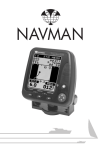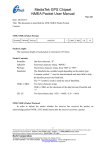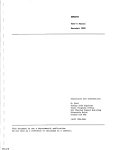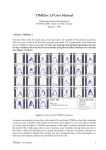Download Raymarine Apelco Clipper 28 Product specifications
Transcript
Distributed by Any reference to Raytheon or RTN in this manual should be interpreted as Raymarine. The names Raytheon and RTN are owned by the Raytheon Company. Apelco GPS11 Installation and Operation Handbook The technical and graphical information contained in this handbook, to the best of our knowledge, was correct as it went to press. However, the Raytheon policy of continuous improvement and updating may change product specifications without prior notice. Therefore, unavoidable differences between the product and handbook may occur from time to time, for which liability cannot be accepted by Raytheon. Copyright Raytheon Marine Europe 1998 Apelco GPS11 Installation and Operation Handbook Package Contents Checking your GPS11 Package The GPS11 package contains the following standard items: 1. Display unit with an internal antenna 2. Lanyard 3. Velcro fixing 4. Mounting bracket (GPS11 plus only) 5. Power and Data connector (GPS11 plus only) 6. Installation & Operation Guide 7. Warranty document Items Missing? If any of the above items are missing or damaged, please contact your Apelco dealer or our Product Support Department to obtain replacement parts. Please note that missing or damaged items cannot be replaced without proof of purchase. Registering this Product Once you have checked that you have all of the listed components, please take the time to complete the warranty document and return it to your national distributor. By returning this document you will receive prompt and expert attention should you ever experience any difficulties with this product. Also, your details are added to our customer database so that you automatically receive new product brochures as and when they are released. Apelco GPS11 Installation and Operation Handbook Package Contents PWR PAGE MARK ENTER PWR PAGE MARK ENTER D4127-1 Standard GPS11 package D4128-1 GPS plus package (see page 12 for accessory pat numbers) Apelco GPS11 Installation and Operation Handbook Contents Contents Checking your GPS11 Package 2 Chapter 1: Introduction 7 Chapter 2: Installation 9 2.1“Velcro” Strap mounting 9 2.2 Bracket Mounting ( GPS11 plus only) 9 2.3 Accessories 12 2.4 External Power connection 14 2.5 External Data Connection 14 Chapter 3: Getting Started 15 3.1 Inserting the batteries 15 3.2 Switching the unit ON and OFF 16 3.3 Light and Contrast 17 3.4 Selecting different pages 18 3.5 Status indicator 18 3.6 Setup 19 3.7 Marking Events 25 3.8 Man Over Board (MOB) 26 Chapter 4: Operation 27 4.1 Satellites Page 27 4.2 Position Page 29 4.3 Waypoint Data Page 29 4.4 Route Data Page 38 4.5 Plotter Page 48 Apelco GPS11 Installation and Operation Handbook Chapter 5: Fault Finding & Maintenance 49 5.1 Fault Finding 49 5.2 How to Contact Apelco 49 5.3 Maintenance 52 Chapter 6: Specification 53 Appendix A : Chart Datums 57 Appendix B : NMEA Output Specifications 67 Chapter 1: Introduction 7 Chapter 1: Introduction Congratulations on the purchase of your Apelco GPS11. This unit is a navigational system consisting of a radio-positioning receiver making use of signals from the NAVSTAR GPS (Global Positioning System). The system offers simultaneously, high accuracy, continuous cover and worldwide availability. This unit may be operated as a purely standalone system supplied by its own internal batteries or may be connected to an external 12v supply and integrated with further instumentation via a NMEA data link. For fixed installation a bracket is provided to allow secure fixing in a wide variaty of positions. Apelco GPS11 Installation and Operation Handbook 8 Important Information All Raytheon equipment and accessories are designed to the highest standard for use in the leisure marine environment. Their design and manufacture conforms to the latest Electromagnetic Compatibility (EMC) standards, but good installation is required to ensure that performance is not compromised. Although every effort has been taken to ensure that they will perform under all conditions, it is important to understand what factors could affect the operation of the product. To avoid the risk of EMC problems, all Raytheon equipment and cables connected to it should be; ❏ At least 1m (3 feet) from any equipment transmitting or cables carrying radio signals e.g. VHF radios, cables and antennas. In the case of SSB radios, the distance should be increased to 2m (7ft). ❏ At least 20m (66 feet) from large vessels equipped with radar. ❏ More than 2m (7 feet) from the direct path of a radar beam. The following points should also be noted; ❏ Genuine Raytheon cables should be used at all times. Cutting and rejoining these cables can compromise EMC performance and so should be avoided unless doing so is detailed in the installation manual. ❏ Raytheon equipment should be serviced only by authorised Raytheon service engineers. They will ensure that service procedures and replacement parts used will not affect EMC performance. There are no user serviceable parts in any Raytheon product. ❏ Voltage drops below 10v in the power supply to our products can cause the equipment to reset. This will not damage the equipment but will cause the loss of some information and can change the operating mode. This most frequently happens during engine starting, and so to reduce the risk of this occurring, it is recommended that the equipment is supplied from a different battery than the one used for engine start. ❏ Some products generate high voltages, and so never handle the cables/ connectors when power is being supplied to the equipment. ❏ Always check the installation before going to sea to make sure that it is not affected by radio transmissions, engine starting etc. ❏ In some installations, it may not be possible to prevent the equipment from being affected by external influences. In general this will not damage the equipment but can lead to it resetting, or momentarily result in faulty operation. Please keep these notes for future reference. Chapter 2: Installation 9 Chapter 2: Installation This chapter covers installation of the support bracket and external cable of the GPS11. If the unit is to be used purely as a standalone handheld GPS then this chapter may be ignored. 2.1 “Velcro” Strap mounting The unit is supplied with a “Velcro” strip which may be attached to the rear case using the lanyard slots. Ensure that the strap is pulled tight and the end tabs turned back and secured to the main strap. Attach the fixing strip to the desired surface using glue or double sided tape or sew the strip onto clothing. 2.2 Bracket Mounting ( GPS11 plus only) The unit is supplied with a universal mounting bracket (selected models only) which will allow your GPS to be slotted into a permanent storage/operating position. 2.2.1 Fixed to a vertical bulkhead Select your desired position and screw the backplate (1) to the vertical bulkhead. Slot the main bracket (2) onto the top tab of the backplate and then push the bottom of the main bracket back, to allow the supplied finger bolt (3) to secure the base of the bracket. D4117-1 10 Apelco GPS11 Installation and Operation Handbook 2.2.2 Fixed to a horizontal surface The bracket may be fixed such that it may be adjusted vertically only or such that it may be rotated and adjusted vertically. For vertical adjustment only screw the backplate (1) to the desired horizontal surface and then secure the main bracket (2) at the desired angle using the finger bolt (3). D4116-1 Chapter 2: Installation 11 To allow the bracket to be rotated assemble the backplate (1) to the main bracket (2) using the finger bolt (3). The angle may be adjusted later if required. Select your desired position and screw the base plate (4) to the horizontal surface, then attach the backplate to the baseplate using the finger bolt (5). D4118-1 Apelco GPS11 Installation and Operation Handbook 12 2.2.3 Fixed to a rail The bracket may be mounted to a rail using the same method as for mounting to a horizontal surface but by reversing the base plate and using stainless steel nuts and bolts (not supplied) to clamp the base plate to the back plate around the rail. D4119-1 2.3 Accessories Carry Case Part No. P36003 A soft carry case is available to protect your GPS11 unit. Bracket Assembly Part No. P36004 (included in GPS11 plus) To allow the standard GPS11 unit to be bracket mounted the bracket assembly that is included in the GPS11 plus kit is available separately. Chapter 2: Installation 13 External Connection There are three external cable accessories available which may be used to connect your GPS11 to external power and data sources. Part No. P36001 Power and Data Cable (included in GPS11 plus) D4124-1 Part No. P36005 Power and Data Cable + PC Connector D4126-1 Note: Ensure that any unused cores are isolated to prevent data loss Part No. P36002 Power Cable with Cigar Lighter Adapter D4125-1 Apelco GPS11 Installation and Operation Handbook 14 2.4 External Power connection The GPS11 may be connected to an external power supply between 10V and 24V d.c.. Connection is made via any of the Power/Data cables shown on page 13 and should be protected by a 5 Amp fuse or circuit breaker. Red 4 Blue 5 3 6 Red 5 Amp Blue 2 1 7 10V - 32V d.c. D4121-1 2.5 External Data Connection The GPS11 is capable of outputing data to other navigational instrumentation or accepting waypoint information from an external source (P.C.). Connection is made via the supplied Power/Data cable. Note: Data communications protocols must be set up correctly in the “SET-UP PORT” section, see page xx. Chapter 3: Getting Started 15 Chapter 3: Getting Started 3.1 Inserting the batteries Open the battery cover on the base of the unit by pulling the compartment latch (1) towards the side of the unit. The battery cover will spring open revealing the black battery carrier within. Remove the carrier and insert the four AA size batteries following the + and - marks. Insert the loaded carrier back into the unit taking care to line up the stud (2) on the carrier with the mark on the cover seal (3). Close the battery cover and pull the latch toward the side of the unit. The cover will click into position sealing the battery compartment. Note: The cover will not close if the battery carrier has been inserted incorrectly. D4120-1 Apelco GPS 11 Installation and Operation Handbook 16 3.2 Switching the unit ON and OFF Press the PWR button to switch on your GPS11. The Startup screen will be displayed for 5 seconds. startup After 5 seconds the GPS satellite information page will be displayed showing the number and identification of the satellites being received. satstat To switch off your GPS11 press and hold down the PWR button. After a one second delay a countdown display will appear. Keep the PWR button held down for a further three seconds until the display switches off. Chapter 3: Getting Started 17 3.3 Light and Contrast After startup the illumination and contrast may be adjusted by pressing the PWR button momentarily. lgtcon Use the trackpad up/down arrows to highlight “BACKLIGHT”, “CONTRAST” or “BACKLIGHT TIME” and press ENTER to select. BACKLIGHT: Use the up/down arrows to select ON or OFF then ENTER to store. CONTRAST: Use the left/right arrows to increase or decrease the contrast to the desired level then ENTER to store. BACKLIGHT TIME: Use the up/down arrows to select the option required then ENTER to store. Options are: 15 or 30 seconds 1, 2 or 4 minutes Continuous Press PAGE to return to the last screen. Note: The backlight will reduce the battery life. The continuous setting is not recommended unless the unit is connected to an external power supply. Apelco GPS 11 Installation and Operation Handbook 18 3.4 Selecting different pages Use of the PAGE button allows the unit to move through the sequence of main operating pages: > SATELLITES < > POSITION < > WAYPOINT DATA < > ROUTE DATA < > PLOTTER < Each page has a menu bar near the bottom of the display. To access a menu use the left/right arrows on the trackpad to highlight the appropriate title and then press ENTER to activate the menu. 3.5 Status indicator The bottom line of the screen shows the units current status and cycles though three sets of information: Battery Status: Full Half Low Number of Satellites being tracked: Chart Datum selected: Position Fix: Illumination: Operating Mode: Differential Fix: Chapter 3: Getting Started 19 3.6 Setup Basic Setup of the GPS11 unit is accessed by highlighting SETUP? on the menu bar on the SATELLITES page. The Setup section is then divided into four sub-menus: SET-UP SYSTEM SET-UP PLOTTER SET-UP NAVIGAT SET-UP PORT Sub menus are accessed by highlighting the appropriate line and pressing ENTER. After switching on select “SETUP?” on the menu bar using the trackpad. Press ENTER to display the main menu. Mainmen1 Apelco GPS 11 Installation and Operation Handbook 20 Set-up System Use the trackpad to select “SET-UP SYSTEM” and press ENTER. Setsys Use the trackpad to highlight the desired option: D/S UNIT: Press ENTER to select the desired units for Speed and Distance. Highlight the desired option and press ENTER to select. Options are: KM - KPH, NM - KT, MI - MPH. ALT. UNITS: Press ENTER to select the desired units for altitude. Highlight the desired option and press ENTER to select. Options are: METRE, FEET, ALTITUDE: Press ENTER to select whether to display or not the altitude information on the Position page.. Options are: ON -display altitude / OFF - not display altitude Chapter 3: Getting Started 21 WARM START Press ENTER to select a start area: AUTO - The unit will search for all satellites and will initiate a cold start if the unit has moved location while switched off. “Selection” - A local area may be selected instructing the unit to search for selected satellites first. Note: When the unit is first switched on the setting of the correct Warm Start region will greatly reduce the time to first fix. The auto setting could result in a time to first fix in excess of 30 minutes. LOCAL TIME Press ENTER to select a time offset from UTC. Use the trackpad to input the correct local time difference for the area you are in and press ENTER to select. ECONOMY MODE Stops GPS reception to increase the battery life of the unit. Use this setting for entering waypoint and route information whilst the unit is not being used for navigation. Options are: Note: ACTIVE - reception disabled NOT ACTIVE - reception enabled Setting is returned to NOT ACTIVE on power up. MAIN MENU? Highlight this option and press ENTER to return to the main menu. Apelco GPS 11 Installation and Operation Handbook 22 Set-up Plotter Use the trackpad to select “SET-UP PLOTTER” and press ENTER. Setplot Use the trackpad to highlight the desired option: CLEAR TRACK: Press ENTER to clear the displays track. A confirmation page will appear . Press ENTER once more to clear the stored track information from the memory. RESET TRIP LOG: Press ENTER to reset the displayed Trip Log. A confirmation page will appear . Press ENTER once more to reset the trip log or use the trackpad to highlight NO? and then press ENTER to cancel. TRACK INTERVAL: Press ENTER to select the time between track data saves. Options are: Note: 5 seconds 30 seconds 1 minute 2 minutes 5 minutes The longer the time interval the larger is the track that can be stored although the resolution of the final plot may be poor if the distances travelled are small. RANGE RINGS: Press ENTER to switch the range rings ON or OFF. Chapter 3: Getting Started 23 WPT DISPLAY: The symbol which displays a waypoint on the plotter screen may be set either to (O) or to the first letter of the waypoint name. Press ENTER to select the desired option. Set-up Navigation Use the trackpad to select “SET-UP NAVIGAT” and press ENTER. Setnav Use the trackpad to highlight the desired option: MAP DATUM: The default map datum is WGS84, however it is possible to select from a list of alternative datums as specified in Appendix A of this manual. Highlight the required datum using the trackpad and press ENTER to select. Note: It is important to ensure the correct datum is selected to prevent position errors being introduced. ANTENNA MODE: For Marine use select the 2 DIMENSIONAL mode and enter the antenna height above sea level to obtain the most accurate position. For land use select 3 DIMENSIONAL mode and allow the GPS unit to calculate height above sea level. Setting the mode to AUTO will cause the GPS to use 3 dimensional mode when it is tracking 4 or more satellites. Apelco GPS 11 Installation and Operation Handbook 24 ALTITUDE If the antenna mode is set to 2 dimensional operation the unit must be told at what height above sea level it is. This will ensure the positional accuracy is maintained. If 3 dimensional operation is selected then altitude need not be entered. COORDINATES Position and waypoint information may be displayed in any one of several systems. Options are: 000000.00’, OSGB, UTM, Swedish Grid COMPASS VARIAT (Variation) Compass bearings may be displayed in Magnetic or True form. If set to 0000 then all bearings displayed will be displayed as True bearing. This unit does not apply variation automatically. Set-up Communications Port Use the trackpad to select “SET-UP PORT” and press ENTER. Setport Use the trackpad to highlight the desired option: Chapter 3: Getting Started 25 SERIAL OUTPUT: Options are: NMEA182, NMEA183, WAYPOINT (for PC waypoint communication) SERIAL INPUT: Options are: DIFFERENTIAL (for differential receiver input), WAYPOINT (for PC waypoint communication) Note: Specifications of the NMEA sentences are given in Appendix B of this manual. 3.7 Marking Events Pressing the EVENT button on the GPS11 enters the current position into the memory as a waypoint. The display will show the position information. Time and date of EVENT automatically entered as a comment Event01 The event is automatically given the name ‘WPT XXX’ where XXX is the next available number. Highlighting SAVE on the menu bar will save the Event as a waypoint which will appear in the waypoint list (see page 34). It is possible to edit any of the Event data by using the trackpad to highlight the relevant piece of information and pressing the ENTER button. It is also possible to save the information as shown and edit later using the Modify Waypoint facility described on page 34). Apelco GPS 11 Installation and Operation Handbook 26 3.8 Man Over Board (MOB) Should a crewmember fall overboard press and hold the EVENT button for 2 seconds. The GPS11 will immediately enter the Plotter screen set to the minimum range. The range will automatically alter to ensure that the MOB position and your current position remain on the display at all times. Mob Use the Bearing and Range figures to steer the vessel back to the original position to recover the casualty. Pressing ENTER will cancel the MOB mode and return to the normal plotter page. Use the PAGE button to continue using the GPS unit normally. Chapter 4: Operation 27 Chapter 4: Operation 4.1 Satellites Page The satellites page shows the status and numbers of satellites being tracked by the GPS11. The main page shows the satellite numbers and the signal strength. satel01 By highlighting DET? on the menu bar and pressing the ENTER button details of azimuth and elevation of the satellites may be viewed. satel02 Apelco GPS11 Installation and Operation Handbook 28 By highlighting DIF? on the menu bar and pressing the ENTER button details regarding a differential fix may be viewed. difinfo RECEPTION QUALITY The bargraph shows the reception quality with a full bar indicating 100% reception DGPS STATION The identification number of the differential station being received will appear automatically. CORRECTED SATS The satellites which are being corrected by the differential station will be indicated by their identification numbers. Chapter 4: Operation 29 4.2 Position Page This page gives your primary position information along with speed and course over the ground. pos01 There are no menu options on this page. 4.3 Waypoint Data Page This page gives your primary waypoint information. Use this page for entering, deleting or editing waypoint information and activating a waypoint. wayp01 There are three menu options “ACTI?”, “EDIT?” and “DISP?” Highlighting “DISP?” on the menu bar will allow the choice of Data, CDI or BDI display. Apelco GPS11 Installation and Operation Handbook 30 Waypoint Display Page From the main waypoint page highlight the “DISP?” option and press “ENTER” you will be presented with three options: Data Shows the main waypoint information page CDI Shows the Course Direction Indicator Page Active waypoint information CDI01 BDI BDI01 Shows the Bearing Direction Indicator Page Chapter 4: Operation 31 Entering, Modifying and Deleting Waypoints From the main Waypoint information page select the menu option “EDIT?” and press the ENTER button. The menu changes to allow three options ENTER?, MODIFY? and DELETE? edit01 Entering a Waypoint Select ENTER? on the menu bar and press the ENTER button. A blank waypoint data page will appear. editwp Apelco GPS11 Installation and Operation Handbook 32 The highlighted setting is WPT:, press ENTER to select the waypoint name option. wptname Use the trackpad up and down arrows to select the first letter or number of your waypoint name then use the right arrow to move on to the next digit. Continue until the waypoint name is complete (max. 6 digits) and press “ENTER”. Use the down arrow to highlight LATITUDE: and press ENTER. lat Use the up and down arrows to select the digits and the right and left arrows to move around until the correct waypoint latitude has been entered. Press the ENTER button. Use the down arrow to highlight LONGITUDE? and press ENTER. lon Repeat the above procedure to enter the correct waypoint longitude. Chapter 4: Operation 33 Use the down arrow to highlight COMMENT: and press ENTER. comment If desired a 20 digit comment may be added to assist later in identifying the waypoint, select letters and numbers as before and press ENTER to complete the waypoint information. wptcompl Check the data entered carefully and, with the VALID? setting highlight on the menu press ENTER to save the information. Note: Failure to highlight VALID? in the menu bar and press the ENTER button will cause the waypoint information to be lost. If the information is incorrect you may use the trackpad arrows to go back and highlight the setting to be changed or highlight CLEAR? on the menu bar to clear the form and start again. Apelco GPS11 Installation and Operation Handbook 34 Modifying a Waypoint Select MODIFY? on the menu bar and press the ENTER button. A list of stored waypoints will appear. wptlst01 Use the trackpad down arrow to highlight the required waypoint. Latitude, Longitude and comments will appear for each waypoint as the list is advanced. Press ENTER when the desired waypoint is located. wptcompl Use the trackpad to navigate around the screen and enter the modifications required. Highlight “VALID?” and press ENTER to store the changes or highlight “ERASE?” and press ENTER to clear the waypoint data and start again. Chapter 4: Operation 35 Deleting a Waypoint Select DELETE? on the menu bar and press the ENTER button. A list of stored waypoints will appear. wptlst01 Use the trackpad down arrow to highlight the required waypoint. Lat/ Lon and comments will appear for each waypoint as the list is advanced. Press ENTER when the desired waypoint is located. delwrn1 Press ENTER once more to confirm waypoint deletion or press PAGE to return to the main Waypoint information page. Note: If the waypoint is used in a route then an error message will appear giving the name of the route in which the waypoint is used. The route must be edited to remove the waypoint before the waypoint can be deleted from the waypoint list. Apelco GPS11 Installation and Operation Handbook 36 Activating a Waypoint To start the GPS11 tracking to a waypoint highlight “ACTI?” on the menu bar and press ENTER. actwpt01 You now have the option to select a waypoint from the stored list or to enter a new waypoint. Activating a Waypoint from the list Highlight “LIST?” on the menu bar and press ENTER. A list of stored waypoints will appear. wptlst01 Use the trackpad down arrow to highlight the required waypoint. Lat/ Lon and comments will appear for each waypoint as the list is advanced. Press ENTER when the desired waypoint is located. Chapter 4: Operation 37 Activating a new Waypoint Highlight NEW? on the menu bar and press the ENTER button. A blank waypoint data page will appear. editwp Follow the procedure on page 31 Entering a Waypoint to complete the form. Check the data entered carefully and, with the VALID? setting highlighted on the menu press ENTER to save the information.. Note: The new waypoint will be stored in memory and added to the waypoint list. If the information is incorrect you may use the trackpad arrows to go back and highlight the setting to be changed or highlight CLEAR? on the menu bar to clear the form and start again To stop tracking to a waypoint highlight “ACTI?” on the menu bar and press ENTER. “DEACTIVATE?” will be highlight on the menu bar. Press ENTER, a warning page will be displayed. stopwarn Press ENTER to stop tracking to that waypoint. Apelco GPS11 Installation and Operation Handbook 38 4.4 Route Data Page This page gives your primary route information. Use this page for entering, deleting or editing route information and activating a stored route. route01 There are three menu options “ACTI?”, “EDIT?” and “DISP?” Highlighting “DISP?” on the menu bar will allow the choice of Data, CDI or BDI displays as indicated on page 30 Waypoint Display Page. Chapter 4: Operation 39 Editing a route Highlight “EDIT?” from the menu bar and press ENTER. Three options are given: “ENTER?”, “MODIFY?” and “DELETE?” Entering a Route Select ENTER? on the menu bar and press the ENTER button. A blank Route data page will appear. edit02 The highlighted setting is RTE:, press ENTER to select the Route number option. rtename Use the trackpad arrows to select the number (00 to 19) of the new route and press “ENTER”. If the route number has already been used, the previously entered route information will be displayed whereas if the route is new the data sheet will be empty. Use the down arrow to highlight the first waypoint line and press ENTER. Apelco GPS11 Installation and Operation Handbook 40 rtewpt01 Use the trackpad to enter the desired waypoint name. As you enter the individual numbers or letters the first matching entry in the waypoint library will be displayed. This allows you to select a waypoint without having to enter the complete name. Press ENTER when the correct waypoint is being displayed to enter the waypoint into the route. rtewp02 Press the down arrow to highlight the next waypoint data line and repeat the above procedure. Continue until the route is complete (maximum 20 waypoints). Check carefully to ensure the route information is correct and highlight “VALID?” on the menu bar and press ENTER. Note: Failure to highlight VALID? in the menu bar and press the ENTER button will cause the waypoint information to be lost. Chapter 4: Operation 41 Modifying a Route Select MODIFY? on the menu bar and press the ENTER button. The Route list page will appear. rtelst Highlight the route to be modified and press ENTER. The route data page will be displayed. modrte Use the trackpad arrows to highlight the waypoint line that requires changing and press ENTER. Select the correct waypoint from the list and press ENTER to update the route. Check the changes carefully , highlight “VALID?” on the menu bar and press ENTER to store the modified route. Apelco GPS11 Installation and Operation Handbook 42 Deleting a Route Select DELETE? on the menu bar and press the ENTER button. The Route list page will appear. rtelst Highlight the route to be deleted and press ENTER. A warning message will be displayed asking for confirmation that the route should be deleted. rtedelcn Press ENTER to confirm deletion or PAGE to return to the main Route Data page. Chapter 4: Operation 43 Activating a Route From the main Route Data page highlight “ACTI?” on the menu bar and press ENTER. actrte01 You now have the option to select a waypoint from the stored list or to enter a new waypoint. Activating a Route from the list Highlight “LIST?” on the menu bar and press ENTER. A list of stored routes will appear. rtelst1 Use the trackpad down arrow to highlight the required route and press ENTER. Apelco GPS11 Installation and Operation Handbook 44 You will be asked to select the direction in which you wish to follow the selected route. rtedir Select Forward or Reverse and press ENTER. You will now be asked to select your start waypoint. The first waypoint of the stored route will be displayed. rtestart If you wish to commence the route from an alternative waypoint use the trackpad up and down arrows to select the desired starting point. Press ENTER when the desired start point is displayed. The selected Route’s data page will be displayed. rtedata1 The GPS11 will start tracking through the selected route. Chapter 4: Operation 45 Activating a new Route Highlight NEW? on the menu bar and press the ENTER button. A blank route data page will appear. Edit02 Follow the procedure on page 38 Entering a Route to complete the form. Check the data entered carefully and, with the VALID? setting highlight on the menu press ENTER to save the information. Note: The new route will be stored in memory and added to the route list. If the information is incorrect you may use the trackpad arrows to go back and highlight the setting to be changed or highlight CLEAR? on the menu bar to clear the form and start again. Apelco GPS11 Installation and Operation Handbook 46 Advancing through a Route When you reach a waypoint there are two options: 1. The GPS position will enter the arrival circle which is preset at 0.1nm and will display the arrival message. wptadv1 Press ENTER to display the Route Data for the next leg and start tracking to the next waypoint. 2. You physically arrive at the waypoint but the GPS position is greater than 0.1nm from the waypoint position (possibly due to poor reception). In this case it will be necessary to manually advance to the next waypoint as shown below. From the Route Data page highlight ACTI? on the menubar and press ENTER. wptadv Use the trackpad to highlight NEXT LEG? and press ENTER. Chapter 4: Operation 47 After a short pause the arrival message will be displayed. wptadv1 Press ENTER to display the Route Data for the next leg and start tracking to the next waypoint. Note: The manual advance may be used at any stage if you wish to bypass a waypoint and track to an alternative later in the Route. De-activating a route To stop tracking through a route highlight “ACTI?” on the menu bar and press ENTER. Use the trackpad to highlight “STOP?” on the menu bar and press ENTER, a warning page will be displayed. stoptrack Press ENTER to stop tracking through the route. Apelco GPS11 Installation and Operation Handbook 48 4.5 Plotter Page The plotter page gives a graphical display of the route history and displays any waypoints that may be in view. Plotter scale and trip log reading plot01 Menu options are ZOOM IN? or ZOOM OUT? Highlight the appropriate instruction and press ENTER to change the plotter scale. The range is from 0.02 to 250 of the units selected. Note: Plotter functions, including clearing the track memory can be accessed via the SET-UP menu Chapter 5: Fault Finding & Maintenance 49 Chapter 5: Fault Finding & Maintenance 5.1 Fault Finding If your GPS11 fails to operate check the battery condition and ensure that the contacts are clean. If an external power source is being used check the voltage and ensure that the Power/Data plug is clean and secure. If the unit powers up but fails to obtain a fix ensure that the unit has a clear view of the sky. Reception will be affected by buildings, trees and other objects that restrict the signal from the satellites, it is wise to check with another GPS operator locally to ensure that the satellite system is fully operational In the unlikely event that a fault develops within the unit there are no user serviceable parts and the complete GPS11 should be returned to a registered Apelco Service Agent for attention. 5.2 How to Contact Apelco In the USA. For technical Support Please call 1-800-539-5539, extension 2445 or (603) 647-7530, extension 2445. Our Fax number is 1-603-634-4756. You may reach our Technical Service Department Monday through Friday, 8:15 A.M. to 5:00 P.M. EasternStandard Time or Daylight Saving Time. Our Technical Support Specialists are available to answer questions about installing, operating, and troubleshooting about your Apelco unit. You may also reach our Technical Support Department via the Internet. Questions may be addressed directly to: [email protected] Or, you may visit Apelco at the World Wide Web site for Raytheon Electronics: www.raymarine.com 50 Apelco GPS11 Installation and Operation Handbook For accessories and parts Please call 1-800-539-5539, extension 2120 or (603) 647-7530, extension 2120. Our Customer Service Department is available Monday through Friday 8:15 A.M.to 5:00 P.M. Eastern Time. Please have the Apelco part number ready when placing an order. (See the optional Accessory List in this manual on page 12.) If you are not sure which item you need for your Apelco unit, please contact our Technical Support Department before placing your order. Apelco accessory items and parts are also available through your authorised Apelco dealer. For product repair and service When you first receive your unit, please be sure to complete and mail the warranty card included in the package. In the unlikely event your Apelco unit should develop a problem, please return the unit to our Product Repair Centre. If you need service help, and you have not mailed your warranty card, please include a copy of your original purchase receipt to verify your warranty status. Please return your unit to this address: Apelco Product Repair Center 676 Island Pond Road Manchester, NH. 03109-5420 Chapter 5: Fault Finding & Maintenance 51 In Europe Contact your Apelco main distributor for assistance for the supply of accessories and technical assistance. Faulty units may also be returned to the distributor or returned directly to: Raytheon Marine Europe Ltd. Robinson Way Anchorage Park Portsmouth, PO3 5TD England The telephone number for Raytheon Marine Europe is (44) 1705 693611. The Fax number is (44) 1705 694642 Contact via the Internet: Questions may be addressed directly to: [email protected] Or, you may visit Apelco at the World Wide Web site for Raytheon Electronics: www.raymarine.com. 52 Apelco GPS11 Installation and Operation Handbook 5.3 Maintenance Chemical and abrasive materials must not be used to clean the GPS11 housing; if it is dirty, clean it with a soft, damp cloth. Examine all cables for chafing or damage to the outer shield and, where necessary, replace with genuine Apelco cables and resecure. Ensure that any external plugs and sockets are kept clean and dry. Use small amounts of a silicon based grease to prevent corrosion on exposed connectors. Chapter 6: Specification 53 Chapter 6: Specification Dimensions Size: 51 x 150 x 33 mm 2.01” x 5.90” x 1.30” Weight: 255g ( 9 oz.) with batteries LCD Display: 100 x 64 FSTN with EL back light. Receiver Frequency: 1.575 GHz, C/A code. Type: 8 genuine parallel channels with phase tracking (predicts the next 4 in view). Antenna: Patch internal / integrated antenna Maximum Speed: 2000km/hour 3 Dimensions: Latitude, Longitude and Altitude; requires 4 or more satellates Pos. Rate Update: 1 second Automatic Selection of Satellites Automatic Almanac update Autolocalization Accuracy Horizontal Position: with SA code : 100m RMS (2D) in RTCM 104 differential mode : 2 to 5 m RMS. Velocity: with SA code : 1.0km/hour RMS in differential mode : 0.1 km/hour Acceleration: 3g Apelco GPS11 Installation and Operation Handbook 54 Time to First Fix (typical) Reaquisition: 4 seconds Up to 1 hour off: 30 seconds Up to 24 hours off: 90 seconds Worldwide cold start: 3 minutes Power Supply Batteries: 4 AA alkaline batteries External Supply: 10-32v dc Battery Life: 8 hrs in continuous permanent mode. 10 hrs in economy permanent mode. 16 hrs in discontiouous mode with a use equivalent to one hour per day. Temperature Operating: -100 to +600C (140 to 1400F) Storage: -200C to +700C (-40 to 1580F) Data Output: NMEA0182, and 0183. Input: NMEA 0183, RTCM 104. Waypoint loading and unloading with P.C. Plotter Functions Plotter Capacity: 300 points Plotter time scale: 25 hours max. Plotter scales: 0.02 to 250 in the units selected Display of waypoints and active route plan. Chapter 6: Specification 55 Main Functions Chart Datums: As shown in Appendix A of this manual. Coordinates: latitude, longitude, UTM, OSGB, Swedish Grid Speed and Course over the Ground. Navigation: Waypoints: 600 waypoints each with 6 alphanumerical character display and automatic classification. Other features: Event mark including 20 reversible routes of 20 wayponts maximum. Range and bearing to a selected waypoint. Total distance covered log. 56 Apelco GPS11 Installation and Operation Handbook Appendix A : Reference Ellipsoids and Datum Table 57 Appendix A : Chart Datums Code Name Abbrev’ 11 Abbrev’ 23 0 WGS 84 WGS84 WGS84DEFAULT 1 Adinan - MEAN FOR Ethiopia, Sudan ADINES ADINANMEANS 2 Adinan - Burkina Faso ADINBUR ADINANBURKIN 3 Adindan - Cameroon ADINCAM ADINANCAMER 4 Adindan - Etiopia ADINETH 5 Adindan - Mali ADINMAL ADINANMALI 6 Adindan - Senegal ADINSEN ADINANSENEG 7 Adindan - Sudan ADINSUD ADINANSUDAN 8 Afgooye - Somalia AFGOSOM AFGOOVESOMALI 9 Ain el Abd 1970 - Bahrain AINBAH AIN1970BAHR 10 Ain el Abd 1970 - Saudi Arabia AINSAUD AIN1970SAUDI 11 Anna 1 Astro 1965 - Cocos Islands ANNCOCO ANNA1COCOSIS 12 Antiguaa Island Astro 1943 Antigua (Leeward Islands) ANT1943 ANTIGUAIS1943 13 Arc 1950 MEAN FOR Botswana, Lethoso, Malawi, Swaziland, Zaire, Zambia, Zimbabwe ARC1950 ARC1950MEAN 14 Arc 1950 - Botswana ARC9501 ARC1950BOTSWA 15 Arc 1950 - Burundi ARC9502 ARC1950BURUND 16 Arc 1950 - Lethoso ARC9503 ARC1950LETHOS 17 Arc 1950 - Malawi ARC9504 ARC1950MALAWI 18 Arc 1950 - Swaziland ARC9505 ARC1950SWAZIL 19 Arc 1950 - Zaire ARC9506 ARC1950ZAIRE 20 Arc 1950 - Zambia ARC9507 ARC1950ZAMBIA 21 Arc 1950 - Zimbabwe ARC9508 ARC1950ZIMBAB 22 Arc 1960 - MEAN FOR Kenya, Tanzania ARC1960 ARC1960MEAN 23 Ascension Island 1958 ASC1958 ASCENSIS1958 ADINANETHIOP Apelco GPS11 Installation and Operation Handbook 58 24 Astro Beacon E 1945 - Iwo Jima IWOJIMA ASTROIWOJIMQA 25 Astro DOS 71/4 - St. Helena Island STHELEN ASTROSTHELISL 26 Astro Tern Island (FRIG) 1961 Tern Island TERNISL ASTROTERN1961 27 Astranomical Station 1952 Marcus Island MARCUIS ASTO1952MARIS 28 Australian Geodetic 1966 Autralia & Tasmania AUSTR66 AUSTRALAIN1966 29 Autralian Geodetic 1984 Autralia & Tasmania AUSTR84 AUSTRALIAN1984 30 Ayabelle Lighthouse - Djibouti DJIBOUT AYABELLEDJIBO 31 Bellevue (IGN) Efate & Erromango Islands BELLVUE BELLEVEFATE 32 Bermuda 1957 - Bermuda BERMUDA BERMUDA1957 33 Bissau - Guniea - Bissau BISSAU BISSAUGUINEA 34 Bogota Observatory - Colombia BOGOTA BOGOTACOLOMBI 35 Bukit Rimpah Indonesia (Bangka & Belitung Islands BUKITRI BUKITRIMPAH 36 Camp Area Astro Antarctica (McMurdo Camp Area) ANTARCT CAMANTARCTICA 37 Campo Inchauspe - Argentina ARGENTI CAMPARGENTIA 38 Canton Astro 1966 - Phoenix Islands PHEONIX CANTON66 39 Cape - South Africa SAFRICA CAPESAFRICA 40 Cape Canaveral - Bahamas, Florida CANAVEL CAPEBAHAMFLO 41 Carthage - Tunisia TUNISIA CARTHAGETUNIS 42 Chaham Island Astro 1971 New Zealand (Chatham Island) CHATHIS CHATHAMIS1971 43 Chua Astro - Paraguay PARAGUY CHUAPARAGUAY 44 Corrego Alegre - Brazil BRAZIL CORREGOBRAZIL 45 Dabola - Guinea GUINEA DABOLAGUNEA 46 Djakarta (Batavia) Indonesia (Sumatra) DJAKARTA DJAKARTAINDON Appendix A : Reference Ellipsoids and Datum Table 59 47 DOS 1968 New Georgia Islands (Gizo Islands) GIZOISL DOS1968GIZOIS 48 Easter Island 1967 - Easter Island EASTISL EASTERISL1967 49 European 1950 MEAN FOR Austria, Belgium, Denmark, Finland, France, West Germany, Gibralter, Greece, Italy, Luxembourg, Netherlands, Norway, Portugal, Spain, Sweden, Switzerland EU19501 EUROPE19501 50 European 1950 MEAN FOR Austria, Denmark, France, West Germany, Netherlands, Switzerland EU19502 EUROPE19502 51 European 1950 MEAN FOR Iraq, Isreal, Jordan, Lebanon, Kuwait, Saudi, Arabia, Syria. EU19503 EUROPE19503 52 European 1950 - Cyprus EU19504 EUROPE19504 53 European 1950 - Egypt EU19505 EUROPE19505 54 European 1950 EU19506 EUROPE19506 England, Channel Islands, Ireland, Scotland, Shetland Islands 55 Eropean 1950 - Finland, Norway EU19507 EUROPE19507 56 European 1950 - Greece EU19508 EUROPE19508 57 European 1950 - Iran EU19509 EUROPE19509 58 European 1950 - Italy (Sardinia) EU195010 EUROPE195010 59 European 1950 - Italy (Sicily) EU195011 EUROPE195011 60 European 1950 - Malta EU195012 EUROPE195012 61 European 1950 - Portugal, Spain EU195013 EUROPE195013 62 European 1979 EUR1979 EUROPE1979 MEAN FOR Austria, Finland, Netherlands, Norway, Spain, Sweden, Switzerland 63 Fort Thomas 1955 Nevis, St. Kitts (Leeward Islands) FTTHOM FTTHOMAS 64 Gan 1970 - Republic of Maldives GAN1970 GAN1970MALDI 65 Geodetic Datum 1949 - New Zealand NEWZEAL GEOD49NEWZEAL Apelco GPS11 Installation and Operation Handbook 60 66 Graciosa Base SW 1948 Azores (Faial, Graciosa, Pico, Sao Jorge, Terciera) AZORES GRACIOSAZORES 67 Guam 1963 - Guam GUAM GUAM1963 68 Gunung Segara - Indonesia (Kalimantan) INDONES GUNUNGSEGARA 69 GUX 1 Astro - Guadalcanal Island GUADISL GUX1ASTRO 70 Herat North - Afganistan AFGHAN 71 Hjorsey 1955 - Iceland ICELAND HJORSEY1955 72 Hong Kong 1963 - Hong Kong HONGKNG HONGKONG1963 73 Hu-Tzu-Shan - Taiwan TAIWAN 74 Indian - Bangladesh BANGLAD INDIANBANGLAD 75 Indian - India, Nepal NEPAL INDIANINDIANEP 76 Indian 1954 - Thailand, Vietnam 54THAIL INDIAN1975THA 77 Indian 1975 - Thailand 75THAIL INDIAN1975THA 78 Ireland 1965 - Ireland IRELAND IRELAND1965 79 ISTS 073 Astro 1968 South Georgia Islands SGEORGA ISTS061AS1968S 80 ISTS 073 Astro 1969 - Diego Garcia DIEGOGA ISTS073AS1969 81 Johnston Island 1961 - Johnston Island JOHNSTN JOHNSTON1961 82 Kandawala - Sri Lanka SRILANK KANDAWALASRIL 83 Kerguelen Island 1949 KERGUIS KERGUELEN1949 84 Kertau 1948 - West Malaysia & Singapore WESTMAL KERTAU1948 85 Kusaie Astro 1961 - Cayman Brac Island CAYBRAC KUSAIEAST1951 86 L. C. 5 Astro 1961 - Cayman Brac Island CAYBRAC LC5ASTRO1961 87 Leigon - Ghana GHANA LEIGONGHANA 88 Liberia 1964 - Liberia LIBERIA LIBERIA1964 89 Luzon - Philippines (Excluding Mindanao) LUZON1 LUZONPHILIPP1 90 Luzon - Philippines (Mindanao) LUZON2 LUZONPHILLIPP2 91 Maha 1971 - Mahe Island MAHAISL MAHA1971 92 Massawa - Ethio[ia (Eritrea) ETHIOPI 93 Merchich - Morocco MOROCCO MERCHICHMOROC 94 Midway Astro 1961 - Midway Islands MIDWYIS MIDWAYAS1961 HERATNORTH HUTZUSHAN MASSAWAETHIOP Appendix A : Reference Ellipsoids and Datum Table 61 95 Minna - Cameroon CAMERN MINNACAMEROON 96 Minna - Nigeria NIGERIA 97 Montserrat Island Astro 1958 Montserrat (Leeward Islands) MONSERT MONTSERIS1958 98 M’Poraloko - Gabon GABON MPORALOKOGAB 99 Nahrwan - Oman (Masirah Island) OMAN NAHRWANOMAN1 100 Nahrwan - Saudi Arabia SAUDIAR NAHRWANSAUDI2 101 Nahrwan - United Arab Emirates UAE NAHRWANUEA3 102 Naparima BWI - Trinidad & Tobago TR&TOB NAPARIMABWI 103 North American 1927 MEAN FOR Antigua, Barbados, Barbuda, Caicos Islands, Cuba, Dominican Republic, Grand Cayman, Jamaica, Turks Islands NAMER1 NAMER19271 104 North American 1927 NAMER2 MEAN FOR Belize, Costa Rica, El Salvador, Guatemala, Honduras, Nicaragua NAMER19272 105 North American 1927 - MEAN FOR Canada NAMER3 NAMER19273 106 North American 1927 MEAN FOR CONUS NAMER4 NAMER19274 107 North American 1927 NAMER5 MEAN FOR CONUS (East Mississippi River) including Louisiana, Missouri, Minesota NAMER19275 108 North American 1927 MEAN FOR CONUS (West of Mississippi River) North American 1927 - Alaska NAMER6 NAMER19276 NAMER7 NAMER19277 109 MINNACAMEROON 110 North Amerian 1927 Bahamas (Acdept San Salvador Island) NAMER8 NAMER19278 111 North American 1927 Bahamas (San Salvador Island) NAMIR9 NAMER19279 112 North American 1927 Canada (Alberta, British Columbia) NAMIR10 NAMER192710 113 North Ameria 1927 Canada (Manitoba, Ontario) NAMIR11 NAMER192711 Apelco GPS11 Installation and Operation Handbook 62 114 North America 1927 Canada (New Brunswick, Newfoundland, Nova Scotia, Quebec) NAMER12 NAMER192712 115 North America 1927 NAMER13 NAMER192713 Canada (Northwest Territories, Saskatchewan) 116 North America 1927 - Canada (Yukon) NAMER14 NAMER192714 117 North American 1927 - Canal Zone NAMER15 NAMER192715 118 North American 1927 - Cuba NAMER16 NAMER192716 119 North American 1927 Greenland (Hayes Peninsula) NAMER17 NAMER192717 120 North American 1927 - Mexico NAMER18 NAMER192718 121 North American 1983 Alaska, Canada, CONUS NAMER19 NAMER192719 122 North American 1983 Central America, Mexico NAMER20 NAMER192720 123 Observatorio Metereo 1939 Azores (Corvo & Flores Islands) AZORES OBSERVMET1939 124 Old Egyptian 1907 - Egypt EGYPT OLDEGYPT1907 125 Old Hawaiian MEAN FOR Hawaii, Kauai, Maui, Oahu OHAWN1 OLDHAWN1 126 Old Hawaiian - Hawaii OHAWN2 OLDHAWN2 127 Old Hawaiian - Kauai OHAWN3 OLDHAWN3 128 Old Hawaiian - Maui OHAWN4 OLDHAWN4 129 Old Hawaiian - Oahu OHAWN5 OLDHAWN5 130 Oman - Oman OMAN OMAN 131 Ord. Survey G. Britain 1936 MEAN FOR England, Isle of Man, Scotland, Shetland Islands, Wales OSGB1 OSGB19361 132 Ord. Survey G. Britain 1936 - England OSGB2 OSGB19362 133 Ord. Survey G. Britain 1936 England, Isle of Man, Wales OSGB3 OSGB19363 134 Ord. Survey G. Britain 1936 Scotland, Shetland Islands OSGB4 OSGB19364 Appendix A : Reference Ellipsoids and Datum Table 63 135 Ord. Survey G. Britain 1936 - Wales OSGB5 OSGB19365 136 Pico de las Nieves - Canary Islands CANISL PICONIEVES 137 Pitcairn Astro 1967 - Pitcairn Islands PITISL PITCAIRN1967 138 Point 58 MEAN FOR Burkina Faso & Niger POINT58 POINT58 139 Pointe Noire 1948 - Congo CONGO POINTEN1948 140 Porto Santo 1936 Porto Santo, Madeira Islands PSANTO POSANTO1936 141 Provisonal S. American 1956 MEAN FOR Bolivia, Chile, Colombia, Ecuador, Guyana, Peru, Venezuela SAMER1 SAMER19561 142 Provisonal S. American 1956 - Bolivia SAMER2 SAMER19562 143 Provisonal S. American 1956 Chile (Southern, Near 430S) SAMER3 SAMER19563 144 Provisonal S. American 1956 Chile (Southern, Near 430S) SAMAR4 SAMER19564 145 Provisonal S. American 1956 - Columbia SAMAR5 SAMER19565 146 Provisonal S. American 1956 - Ecuador SAMAR6 SAMER19566 147 Provisonal S. American 1956 - Guyana SAMER7 SAMER19567 148 Provisonal S. American 1956 - Peru SAMER8 SAMER19568 149 Provisonal S. American 1956 - Venezuela SAMER9 SAMER19569 150 Provisional S. Chilean 1963 Chile (South , Near 530S) (Hito XVIII) CHILE SCHILE1963 151 Puerto Rico - Puerto Rico, Virgin Islands PUERTOR PUERTORICO 152 Qatar National - Qatar QATAR 153 Qornoq - Greenlan (South) GREENDS QORNOQGREENLD 154 Reunion - Mascarene Islands MASCISL REUNIONMASCA 155 Rome 1940 - Italy (Sardinia) SARDINI ROME 1940ITALY 156 Santo (DOS) 1965 Espirito Santo Islands ESPIRIT SANTODOS1965 157 Sau Braz Azores (Sao Miguel, Santa Maria Islands SAOBRAZ SAOBRAZAZORES QATARNATIONAL Apelco GPS11 Installation and Operation Handbook 64 158 Sapper Hill 1943 - East Falkland Islands EFALKLD SAPPERHILL43 159 Schwareck - Namibia NAMIBIA SCHWARZECK 160 Selvagem Grande - Salvage Islands SALVAGI SELVAGEMGRAND 161 SGS 85 - Soviet Geodetic System 1985 SGS85 SGS85SOVIET85 162 South American 1969 SAMER10 SAMER196910 MEAN FOR Argentina, Bolivia, Brazil, Chile, Colombia, Ecuador, Guyana, Paraguay, Peru, Trinidad & Tobago, Venezuela 163 South American 1969 - Argentina SAMER11 SAMER196911 164 South American 1969 - Bolivia SAMER12 SAMER196912 165 South American 1969 - Brazil SAMER13 SAMER196913 166 South American 1969 - Chile SAMER14 SAMER196914 167 South American 1969 - Colombia SAMER15 SAMER196915 168 South American 1969 - Equador SAMER16 SAMER196916 169 South American 1969 Ecuador (Baltra, Galapagos) SAMER17 SAMER196917 170 South American 1969 - Guyana SAMER18 SAMER196918 171 South American 1969 - Paraguay SAMER19 SAMER196919 172 South American 1969 - Peru SAMER20 SAMER196920 173 South American 1969 - Trinidad & Tobago SAMER21 SAMER196921 174 South American 1969 - Venezuala SAMER22 SAMER196922 175 South Asia - Singapore SINGAPR SOUTHASIASING 176 Tananarive Observatory 1925 Madagascar MADAG TANANARIV1925 177 Timbalai 1948 Brunei, East MAlaysia (Sabah, Sarawak) BRUNEI TIMBALI1948 178 Tokyo - MEAN FOR Japan, Korea, Okinawa TOKYO1 TOKYO1 179 Tokyo - Japan TOKYO2 TOKYO2 180 Tokyo - Korea TOKYO3 TOKYO3 181 Tokyo - Okinawa TOKYO4 TOKYO4 182 Tristan Astro 1968 - Tristan da Cunha TRISTAN TRISTANAST1968 183 Viti Levu 1916 - Fiji (Viti Levu Island) VITLEVU VITILEVU1916 Appendix A : Reference Ellipsoids and Datum Table 65 184 Wake-Eniwetok 1960 - Marchall Islands WAKEENI WAKEENIWE1960 185 Wake Island Astro 1952- Wake Atoll WAKEATO WAKEASTRO1952 186 WGS 1972 - Global Definition WGS1972 WGS1972 187 Yacare - Uruguay YACARE YACARE 188 Zanderij - Suriname ZANDERI ZANDERIJ 66 Apelco GPS11 Installation and Operation Handbook Appendix B : Data Output/Input Specifications Appendix B : NMEA Output Specifications 1 - NMEA 0182 or NMEA 0180 COMPLEX 8 DATA bits, D7 bit = 1, 1 STOP bit, 1200 BAUD, even parity, rate 4 s. 2 - NMEA 0183 Version 2.1 8 DATA bits,D7 bit = 0, 1 STOP bit, 4800 BAUD, no parity Sentences transmitted: -APB Automatic pilot format B -BWC Waypoint, Range and bearing -GLL Geographic Position - Latitude/Longitude -GGA Global Positioning System Fix Data -RMB Recommended Min. Navigation Information -RMC Recommended Min. Specific GPS/TRANSIT Data -VTG Speed and Course -ZTG UTC and Time to Destination Waypoint Sentence information is shown on the following pages. 67 Waypoint ID Distance, nautical miles Bearing, degrees magnetic Bearing, degrees true Waypoint longitude, E/W Waypoint latitude, N/S UTC of observation $BWC, hhmmss,llll.lll, a, yyyyy.yyy, a, x.x, T, x.x, M, x.x, N, c--c *hh<CR><LF> -BWC Bearing and Distance to Waypoint Heading to steer to destination waypoint magnetic or true Bearing, Present position to destination magnetic or true Destination waypoint ID Bearing origin to waypoint magnetic or true Status: A = perpendicular passed at waypoint Status: A = arrival circle entered XTE units, nautical miles Direction to steer L/R Magnitude of XTE (cross track error) Status: A = Data valid or not used, V = Loran-C cycle lock warning flag Status: A = Data Valid V = Loran-C blink or SNR warning V = General warning flag for other navigation systems when a reliable fix is not available $APB, A, A, x.x, a, N, A, A, x.x, a, c--c, x.x, a, x.x, a *hh<CR><LF> -APB Automatic pilot format B 68 Apelco GPS11 Installation and Operation Handbook Latitude, N/S Status: A = valid data, V = Navigation receiver warning UTC of position Magnetic variation, E/W Date: dd|mm|yy Course over ground, degrees true Speed over ground, knots Longitude, E/W $RMC, hhmmss, A, llll.lll, a, yyyyy.yyy, a, x.x, x.x, xxxxxx, x.x, a *hh<CR><LF> -RMC Recommended Minimum Specific GPS?TRANSIT Data Arrivial Status: A = arrival circle entered or perpendicular passed V = not entered / passed Destination closing velocity, knots Bearing to destination, degrees true Range to destination waypoint, nautical miles Destination waypoint longitude, E/W Destination waypoint latitude, N/S Destination waypoint ID Origin waypoint ID Direction to steer, L/R Cross track error, nautical miles Data status: A = Data valid, V = Navigation receiver warning $RMB, A, x.x, a, c--c, c--c, llll.lll, a, yyyyy.yyy, a, x.x, x.x, x.x, A *hh<CR><LF> -RMB Recommended Minimum Navigation Information Appendix B : Data Output/Input Specifications 69 Latitude, N/S Status: A= valid, V = not valid UTC of position Longitude, E/W $GLL, llll.lll, a, yyyyy.yyy, a, hhmmss, A *hh<CR><LF> -GLL Geographic Position - Latitude/Lingitude Latitude, N/S UTC of position Differential reference station ID Age of Differential GPS data Units of geoidal separation, meters Geoidal separation Units of antenna altitude, meters Antenna altitude re: mean-sea level (geoid) Horizontal dilution of position Number of satellaties in use GPS quality indicator Longitude, E/W $GGA, hhmmss,llll.lll,a, yyyyy.yyy, a, x, xx, x.x, x.x, M, x.x, M, x.x, xxxx *hh<CR><LF> -GGA Global Positioning System Fix Data 70 Apelco GPS11 Installation and Operation Handbook Destination waypoint ID Time to go, hh = 00 to 99 UTC of observation $ZTG, hhmmss, hhmmss, c--c *hh<CR><LF> -ZTG UTC and Time to Destination Waypoint Speed over ground, km/hr Speed over ground, knots Course, degrees magnetic Course, degrees true $VTG, x.x, T, x.x,M, x.x, N, x.x, K *hh<CR><LF> -VTG Speed and Course Appendix B : Data Output/Input Specifications 71 72 Apelco GPS11 Installation and Operation Handbook Document Number: 81145-1 Raytheon Marine Company 676 Island Pond Road Manchester, NH 03109-5420 USA TEL (603) 647-7530 FAX (603) 634-4756 http://www.raytheon.com Raytheon Marine Europe Ltd. Anchorage Park, Portsmouth Hampshire, PO3 5TD England TEL +44 (0) 1705 693611 FAX +44 (0) 1705 694642 Printed in France
























































































